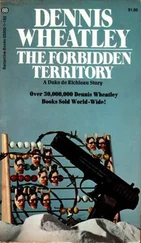A few minutes later, he congratulated her on the courage she had shown so far, urged her to keep it up, and rang the bell for Mrs. Sutton to let him out. When the wardress had done so he said to her:
'Now that I have been put on this case I'd like to get a full picture of the prisoner's surroundings and the routine she follows. I've no wish at all to interfere materially with your arrangements, but sometimes quite slight changes make them much more amenable to reason.'
Mrs. Sutton obliged at once. She reeled off the schedule for Sabine's day, then took him up the short flight of stairs leading up from the hall. Above was a servant's bedroom from which the furniture had not been removed and in it Sabine was locked up at nights. When they came down she conducted him over what must in normal times have been a spacious and charming flat. Now, most of its rooms were half empty, with soot in the fireplaces and on the floors plaster brought down by the bomb blast. They then looked in on the room which was being used by the two wardresses as a bedroom; and lastly visited the kitchen in which the other wardress, a Mrs. Wright, had just started to prepare the evening meal.
Mrs. Wright had carroty hair and a freckled face. She was somewhat younger and a little taller than Mrs. Sutton but looked just as formidable. Gregory shook hands with her. He did not suggest any changes, said that he expected to be there again the following day, and took his departure.
Outside, there were no taxis to be had, so he took the Underground to St. James's Park, picked up one there and had himself driven to Boodle's. After an hour spent drinking with friends in his Club, he walked across the road to the M.I.5 building. Five minutes later he was making his report to 'Himmler.'
Having greatly intrigued the purposeful looking Colonel by giving him Sabine's version of Ribbentrop's plot for planting her on Sir Pellinore, Gregory doled out some of the information she had supplied about the Moldavians. After the past failures of his regular interrogators this was quite enough to encourage the Colonel to leave the interrogation in Gregory's hands, and even to press him to push on with it.
Gregory said that as he was due to go on night duty after dinner and would need a few hours' sleep in the morning, he would prefer not to go to the Tower again until the following afternoon. He added that he thought it would ease the wheels a bit further if he might provide the prisoner with some drink and, when he had a chance, collect for her some of her warmer clothes that she had left at Carlton House Terrace.
'Go down there whenever it suits you best, my dear fellow,' replied 'Himmler' cordially. 'You have made an excellent beginning. I'll telephone Colonel Faviell and tell him you are to be given access to the prisoner at whatever hours you like. As far as drink is concerned, there is no objection to your supplying her with a few bottles…' he laughed suddenly '… providing, of course, that you don't expect the "firm" to pay for it. I've no objection either to your taking her down some of her warmer clothes. Forgive me now. I still have a lot to do. Let me know how you get on.'
For several days past the Desert Air Force had been carrying out intensive attacks against Rommel's positions and communications; and, early in the morning, when Gregory and his colleagues were drowsing in the dimmed lights of the War Room, they were roused by the shrilling of one of the telephones. A signal had just come through that by the light of a brilliant full moon, General Montgomery had launched the Eighth Army from El Alamein in operation Lightfoot, the full-scale offensive which it had been planned should precede Torch.
Later that day, Saturday, October the 24th, after a good sleep, a bath and lunch, Gregory again went down to the Tower. To his considerable satisfaction the Governor informed him that the prisoner had been reported sick that morning. The doctor could not say exactly what was wrong with her. It was not 'flu but seemed to be a form of low fever. She was in no danger, anyhow for the moment, but in bed, of course, and might not be up to further interrogation for a day or two.
'Then I've had my journey for nothing,' said Gregory. 'Unless… yes, unless you will allow me to take the opportunity of going round the Tower. It is years since I've seen it properly, and…'
The Colonel was on his feet in an instant, exclaiming enthusiastically, 'But of course! I'll show you round myself! Delighted to do so! Wonderful old place this! In normal times we get thousands of foreign visitors but it staggers me how few English people bother to come here. You would think being able to look at the Crown Jewels would be enough to induce them to visit us even if there were nothing else to see. But there are more things of interest in the Tower than there are in all the other historical buildings in London put together. It is the whole of English history from 1066. Before that even. We have still standing part of the original Roman wall built round ancient London, and in 885 repaired by Alfred the Great. It was in this house that Elizabeth was imprisoned before she became Queen, and Guy Fawkes was tried upstairs in the Council Chamber after the Gunpowder Plot. Come along and I'll show you.'
They inspected the State Axe and the site of the Block on Tower Hill, where so many noble heads had rolled. In the White Tower they visited the Chapel built by William the Conqueror one of the most perfect examples of Norman architecture in England and the wonderful collections of arms, armour and military trophies; then saw the instruments of torture in the basement, and the spot where the bones of the two murdered Princes in the Tower had been discovered in the time of Charles II. But the Bloody Tower was said to have been the actual scene of that crime, and of many others. In the stone walls of its chambers could still be seen the prayers and inscriptions cut so patiently by men and women who had made history and, mostly, left it only for the scaffold.
Coming out of the archway under it, the pit in which lay Traitors' Gate was immediately opposite them. Crossing Water Lane they halted by the guard rail which fenced off the broad flight of stairs up which Prisoners of State had come after landing from the barge that had brought them down the Thames.
'May I go down and look through to the far end of the tunnel?' Gregory asked innocently.
'By all means, if you like,' the Colonel replied. 'But it is blocked up. Has been ever since the Duke of Wellington had the moat drained when he was Governor here. So it comes to a dead end against the embankment, which is at the same level as this on the other side.'
Throwing a leg over the rail Gregory slipped down on to the top step, ran quickly down the others and across the floor of the old moat to the gate. Its two halves were both formed from five thick horizontal beams, each held to the other by some twenty upright bars about six inches apart. The two central beams had slots holding a stout crossbar which was secured by the biggest padlock Gregory had ever seen. From end to end if was a foot in length and its semicircular clasp was at least an inch in diameter.
The gate had no other fastenings at its top or bottom, but one glance was enough to show Gregory that the padlock would prove too much for him. To have filed through the hinged clasp would have taken hours and to blow the lock would have needed so big a charge that its explosion must be heard. Even if by bringing in a Bunsen burner he could have cut through the clasp fairly quickly there remained the question of whether he would be able to get the gate open; and there was no way in which he could test that before the event. Each side of it, he reckoned, must weigh something in the neighbourhood of a ton, and all the odds were that it had not been opened for years; so the great hinges would have rusted and made it impossible to shift.
Читать дальше










